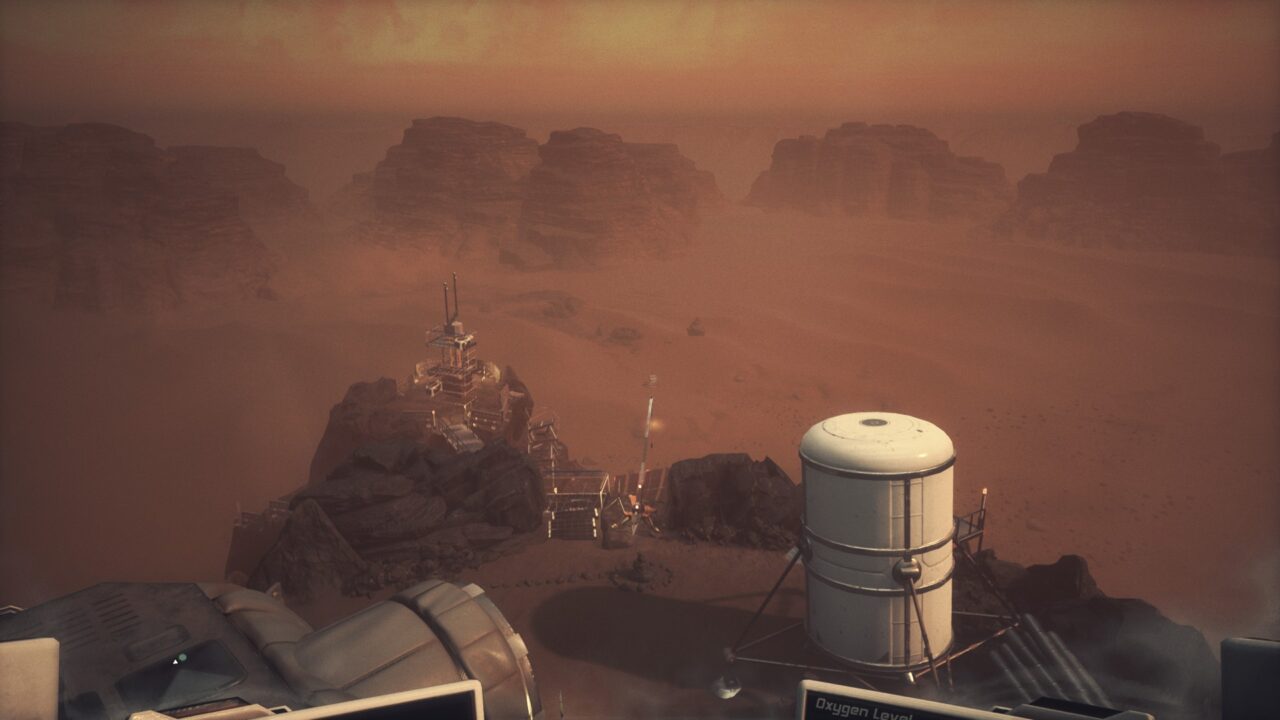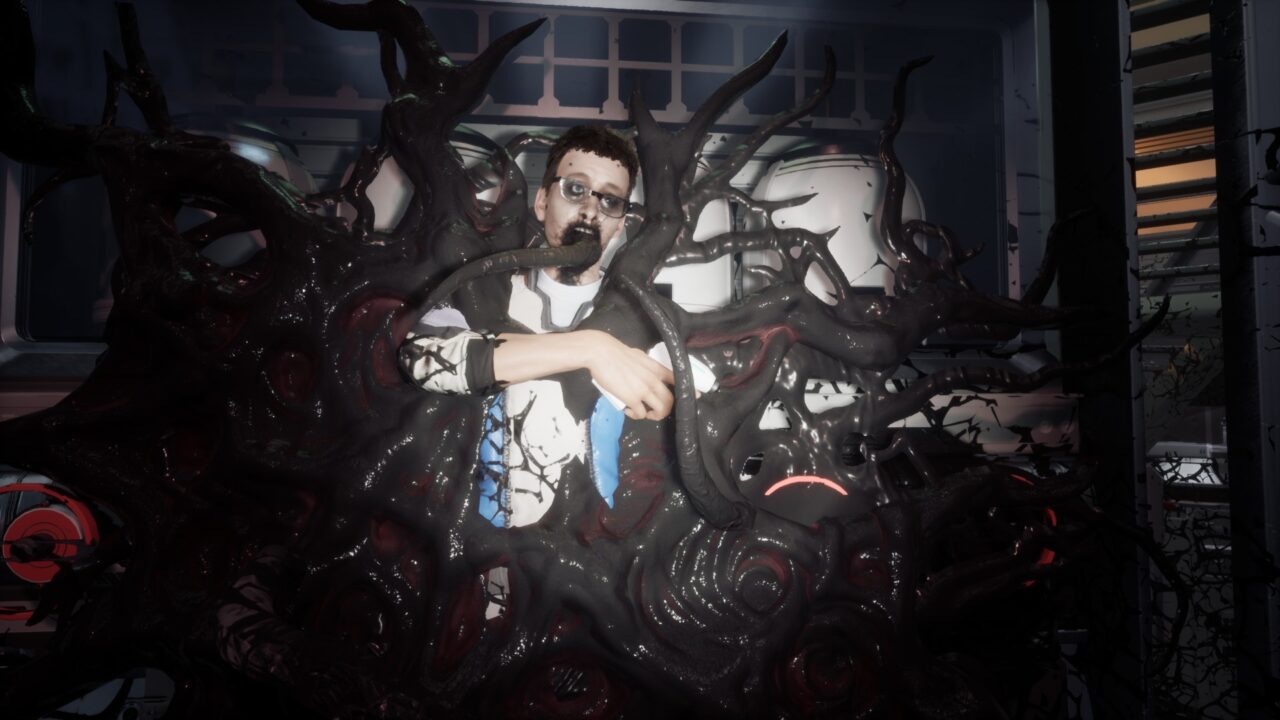MOONS OF MADNESS REVIEW – Actually Cosmic Cosmic Horror

Developed by Rock Pocket Games
Published by Funcom
Available on PS4, Xbox One, and PC
MSRP $24.99
You know, I don’t think I’ve ever played a Lovecraftian game in space. We’ve had plenty of steampunk Lovecraft, 1920’s Lovecraft, medieval Lovecraft, underwater Lovecraft, but no space Lovecraft. I guess Dead Space, if we’re just counting anything that has tentacles as “Lovecraftian.” It’s kind of ironic that we haven’t seen more cosmic horror set in the cosmos. So before you go looking down your nose at Moons of Madness for just being anachronistic, maybe it’s right and all the other ones were wrong.
So as my previous paragraph gave away, Moons of Madness is another Lovecraft game. Not that it was trying to keep that a secret. The box art is a spaceman being attacked by tentacles from beyond the stars. It says right on the store page, “scientific exploration of Mars meets the supernatural dread of Lovecraft.” So we all know what to expect: nightmare sequences, waking up from said nightmare sequences muttering, “was that a dream, it seemed so real,” finding things from said nightmare sequence later in the game while the character explains, “it’s the object from my dream,” people losing their minds over their own nightmare sequences, people conducting rituals they saw in a nightmare, and tentacles. But this isn’t just “Lovecraft inspired” like so many other horror titles where the foe is some unknowable shadowy evil with too many appendages. No, Moons of Madness has full-blown Cthulhu statues and the Necronomicon.
Not that any of that makes Moons of Madness bad. Don’t go fucking with a perfectly functional formula. And to its credit, Moons of Madness does enough different to make it more than just, “another one.” You play as Shane Newehart, a space engineer with a troubled past. Stationed on the secret Mars base Trailblazer Alpha, your mission is to find evidence of alien life for the Orochi Corporation. Well, that’s the team’s mission anyway. Your mission is to make sure the lights work and the pipes aren’t leaking. You’re more of a space handyman than a super serious science guy.
Shane awakens one morning from a Lovecraftian Nightmare™ to find that things on Trailblazer Alpha are slowly making their way to tits-up. First, the lights aren’t working. Bummer, best go fix that. Turns out, the station’s automated solar panels aren’t calibrated. Fixing the panels restores power to the base, but that reveals that the water filtration isn’t working. Time to go patch up some leaky pipes. So you get the water filtration back online, only to awaken station’s human/plant hybrid that devours worlds. Darn, what a pickle. It’s really true what they say: in space, just one minor problem can spiral into a catastrophe. You let one wrench get rusty, and before you know it you have a portal to R’lyeh.
Things only get nuttier from the plant monster. Needless to say, plenty of eldritch happenings are afoot. However, Moons of Madness takes a distinctly rational approach to horrors from beyond the stars. It’s science gone mad, not cultists performing ancient rituals. The end goal in both cases is to commune with the chittering horrors from the borders of our reality. But in Moons of Madness, it’s more likely the result of careful experimentation or brute-force algorithms.
It’s not the first time that Lovecraft has been analyzed through a more “scientific” lense. That being said, this is the most realistic take I’ve seen. If Elder Gods did exist, this is most likely how we’d go about trying to study them. Aside from the nightmare monsters and tentacles, the game does its best to stay planted firmly in reality. There are no laser battles or exo-suits to take you out of the experience. Moons of Madness is remarkably grounded for a game about a time-traveling witch summoning Cthulhu on Mars.
As interesting as the plot is, Moons of Madness lags in the gameplay department. There isn’t much action in Moons (save from the parts where you run from monsters while the camera shakes, which is mandated by law for all horror games). Most of the gameplay comes in the form of various puzzles. There are about one or two major puzzles per level, with optional text logs for you to read in between. Each puzzle is good, and mechanics are rarely recycled. Even so, it’s only about a dozen puzzles total.

My biggest peeve with Moons of Madness is that all of the puzzles are obviously just ways to make it feel more like a game and less like a movie. Now obviously games need to have gameplay. But most of the puzzles didn’t feel like part of the world. Every time I came across another roadblock, the reasoning felt like the writer coming up with excuses for gameplay. The water filtration isn’t broken because it’s crap and you’ve done this a bunch before, it’s broken because someone has messed with it for the plot. The same goes for the power being out, the communications being down, and even the plant monster. It’s not a major complaint, but it did mildly hinder my immersion.
Perhaps this is all because of the lack of collectibles. I’ve said for a while now that horror games need to stop fixating on extra collectible documents and doodads just to lengthen gameplay. After playing Moons of Madness, I might need to rethink that statement. Without those little extras filling in the spaces, it all just feels like empty air between the mandatory setpieces. I felt myself glossing over the world’s details, automatically filtering them out as empty space. There aren’t a lot of extra rooms in the game, but I eventually stopped even looking for them. The game could do with one or two more carrots to draw you along and get you to pay that bit of extra attention to what’s happening.

There’s a lot to like in Moons of Madness. It’s an interesting premise, and the puzzle design is solid. It offers a decent challenge without ever being frustrating. I just wish there was more of it. It all takes place in a single day, and I never got the sense of who these characters were or why this all mattered. The story constantly presents you with these little glimpses of something greater, then moves along. I wish I had more time in this world, learning about the ship and its inhabitants building up to this moment. I genuinely love what they did with the setting and source material, but I could see the seems in the fabric. It didn’t ruin it, but it did hamper what was an otherwise fascinating and unique Cthulhu story. Still, if my biggest complaint is that there needed to be more, then Moons of Madness did something very right.
-
Game
Summary
Moons of Madness packs some solid scares and an interesting story. Unfortunately, the gameplay is too sparse to warrant a universal recommendation. A good pickup for horror fanatics.
Categorized:Horror Gaming Reviews




